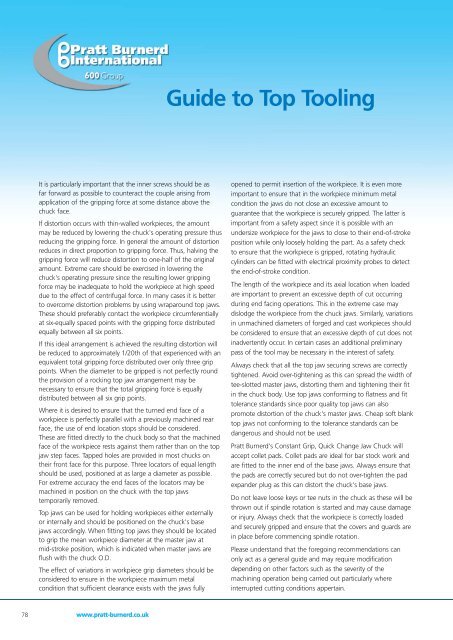Workholding Cat PRINT
Workholding Cat PRINT
Workholding Cat PRINT
You also want an ePaper? Increase the reach of your titles
YUMPU automatically turns print PDFs into web optimized ePapers that Google loves.
It is particularly important that the inner screws should be as<br />
far forward as possible to counteract the couple arising from<br />
application of the gripping force at some distance above the<br />
chuck face.<br />
If distortion occurs with thin-walled workpieces, the amount<br />
may be reduced by lowering the chuck's operating pressure thus<br />
reducing the gripping force. In general the amount of distortion<br />
reduces in direct proportion to gripping force. Thus, halving the<br />
gripping force will reduce distortion to one-half of the original<br />
amount. Extreme care should be exercised in lowering the<br />
chuck's operating pressure since the resulting lower gripping<br />
force may be inadequate to hold the workpiece at high speed<br />
due to the effect of centrifugal force. In many cases it is better<br />
to overcome distortion problems by using wraparound top jaws.<br />
These should preferably contact the workpiece circumferentially<br />
at six-equally spaced points with the gripping force distributed<br />
equally between all six points.<br />
If this ideal arrangement is achieved the resulting distortion will<br />
be reduced to approximately 1/20th of that experienced with an<br />
equivalent total gripping force distributed over only three grip<br />
points. When the diameter to be gripped is not perfectly round<br />
the provision of a rocking top jaw arrangement may be<br />
necessary to ensure that the total gripping force is equally<br />
distributed between all six grip points.<br />
Where it is desired to ensure that the turned end face of a<br />
workpiece is perfectly parallel with a previously machined rear<br />
face, the use of end location stops should be considered.<br />
These are fitted directly to the chuck body so that the machined<br />
face of the workpiece rests against them rather than on the top<br />
jaw step faces. Tapped holes are provided in most chucks on<br />
their front face for this purpose. Three locators of equal length<br />
should be used, positioned at as large a diameter as possible.<br />
For extreme accuracy the end faces of the locators may be<br />
machined in position on the chuck with the top jaws<br />
temporarily removed.<br />
Top jaws can be used for holding workpieces either externally<br />
or internally and should be positioned on the chuck's base<br />
jaws accordingly. When fitting top jaws they should be located<br />
to grip the mean workpiece diameter at the master jaw at<br />
mid-stroke position, which is indicated when master jaws are<br />
flush with the chuck O.D.<br />
The effect of variations in workpiece grip diameters should be<br />
considered to ensure in the workpiece maximum metal<br />
condition that sufficient clearance exists with the jaws fully<br />
78 www.pratt-burnerd.co.uk<br />
Guide to Top Tooling<br />
opened to permit insertion of the workpiece. It is even more<br />
important to ensure that in the workpiece minimum metal<br />
condition the jaws do not close an excessive amount to<br />
guarantee that the workpiece is securely gripped. The latter is<br />
important from a safety aspect since it is possible with an<br />
undersize workpiece for the jaws to close to their end-of-stroke<br />
position while only loosely holding the part. As a safety check<br />
to ensure that the workpiece is gripped, rotating hydraulic<br />
cylinders can be fitted with electrical proximity probes to detect<br />
the end-of-stroke condition.<br />
The length of the workpiece and its axial location when loaded<br />
are important to prevent an excessive depth of cut occurring<br />
during end facing operations. This in the extreme case may<br />
dislodge the workpiece from the chuck jaws. Similarly, variations<br />
in unmachined diameters of forged and cast workpieces should<br />
be considered to ensure that an excessive depth of cut does not<br />
inadvertently occur. In certain cases an additional preliminary<br />
pass of the tool may be necessary in the interest of safety.<br />
Always check that all the top jaw securing screws are correctly<br />
tightened. Avoid over-tightening as this can spread the width of<br />
tee-slotted master jaws, distorting them and tightening their fit<br />
in the chuck body. Use top jaws conforming to flatness and fit<br />
tolerance standards since poor quality top jaws can also<br />
promote distortion of the chuck's master jaws. Cheap soft blank<br />
top jaws not conforming to the tolerance standards can be<br />
dangerous and should not be used.<br />
Pratt Burnerd's Constant Grip, Quick Change Jaw Chuck will<br />
accept collet pads. Collet pads are ideal for bar stock work and<br />
are fitted to the inner end of the base jaws. Always ensure that<br />
the pads are correctly secured but do not over-tighten the pad<br />
expander plug as this can distort the chuck's base jaws.<br />
Do not leave loose keys or tee nuts in the chuck as these will be<br />
thrown out if spindle rotation is started and may cause damage<br />
or injury. Always check that the workpiece is correctly loaded<br />
and securely gripped and ensure that the covers and guards are<br />
in place before commencing spindle rotation.<br />
Please understand that the foregoing recommendations can<br />
only act as a general guide and may require modification<br />
depending on other factors such as the severity of the<br />
machining operation being carried out particularly where<br />
interrupted cutting conditions appertain.


